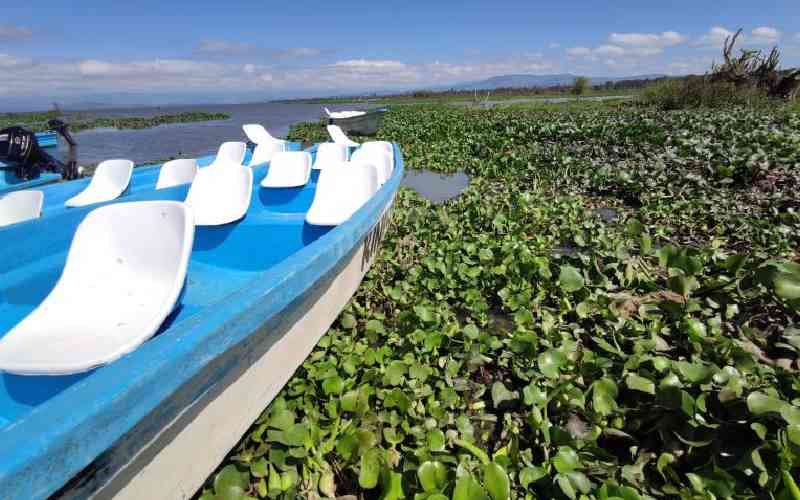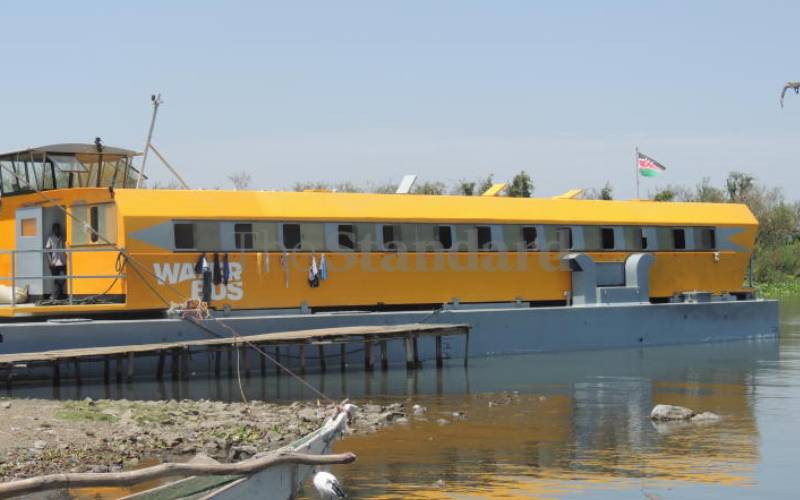Lake Victoria, Africa’s largest fresh water body, is suffocating under water hyacinth, raising questions about the multi- billion-shilling project to eliminate it.
The weed has blocked all the fish-landing beaches, paralysing fishing activities and lake transport.
Yesterday, fishermen along the lake shores said they were losing up to Sh16 million daily due to the hyacinth.
And with water transport paralysed across the lake, communities are trekking long distances in search of alternative sources to get across.
According to Kenya Maritime Authority (KMA) statistics, there are about 160 beaches along the Kenyan shores, where an estimated 40,000 vessels operate. The authority is yet to survey the area covered by the weed.
Dunga Beach Management Unit (BMU) chairman Joel Otieno said the smallest beaches recorded sales of up to Sh100,000 daily.
Mr Otieno said the weed had already engulfed some beaches, forcing fishermen to halt operations as county governments continued to turn a blind eye.
FULLY ENGULFED
“As we speak, Kichinjio Beach is fully engulfed and Nyamware Beach in Nyando is partially covered. All the beaches may soon be covered,” he said. “Up to last week, we were trying to remove the weed physically but it has proved impossible as more of it comes with the wind and covers larger areas.”
Paul Ouma, a leisure boat operator at Lwang’ni Beach in Kisumu County, said during the festive season, boat rides were halted for security reasons.
“We have very little to do with this. We make between Sh10,000 and Sh25,000 every day, which we have had to forgo for the last one month because of the hyacinth,” Mr Ouma said.
And now, environmental researchers are asking hard questions about the water hyacinth control programme, which they say had gobbled up billions of shillings without showing tangible results.
“We began the fight against the weed at the same time as Uganda. They seem to be doing better. The World Bank has funded the Lake Victoria environmental programme... but the weed continues to choke the lake,” said Edwin Rukwaro, a London-based researcher who has studied Lake Victoria.
“I think it is time we audited the fight against the hyacinth weed because something seems to be wrong. We have tried many methods and brought in many experts but we are still stuck with the weed.”
Dr Rukwaro said the first attempt to clear the weed was in the late 1990s, when the national government contracted Aquarius Systems Co Ltd from the United States to mechanically harvest 1,500 hectares.
Stay informed. Subscribe to our newsletter
“They were paid Sh100 million. The company left the country but the weed remained intact.”
Around the same period, the Kenya Agricultural Research Institute (Kari) came up with a biological approach in which it proposed the use of beetles, imported from South Africa, to eat the thick carpets of hyacinth.
Kari imported 13,800 adult Neochetina weevils from Australia, Uganda and South Africa for mass rearing. Over 4.2 million weevils were released on the lake. But there were complaints that the insects were leaving the hyacinth and invading farmers’ crops.
PROJECT HALTED
“After nearly one year, the project was halted. Kari claimed the weevils had reduced the weed by more than 50 per cent but a few months later, the weed invaded the lake with a vengeance. Some scientists said the resurgence was as a result of faster reproduction of the weed due to pollution in the lake,” Rukwaro said.
At one time, a Kisumu scientist claimed he could use domestic ducks to destroy the weed. But the national government nipped his plans in the bud.
According to KMA Western Kenya Regional Manager Jeremiah Onyango, the weed has never been eradicated from the lake since it was reported more than a decade ago.
He said the changing direction of wind had seen the weed moved from different gulfs, with the current southern wind pushing it to Kenyan shores.
“The only solution is harvesting the weed and getting it out of the lake, just like the Ugandans have done,” Mr Onyango said.
He said the last three months alone had seen more than five boats marooned on the lake for between three and five days.
“We have warned boat operators to stay away from the lake until something is done because it is very risky. The weed has never left the lake gulf. It has been in some parts of the lake in south Nyanza and the southern wind is now pushing it towards Kisumu,” Onyango said.
“To clear the weed, everybody must come out and do their part. We know the economy of so many people will be affected for the time being, and that is why the county governments must act quickly to clear the weed from the lake.”
 The Standard Group Plc is a
multi-media organization with investments in media platforms spanning newspaper
print operations, television, radio broadcasting, digital and online services. The
Standard Group is recognized as a leading multi-media house in Kenya with a key
influence in matters of national and international interest.
The Standard Group Plc is a
multi-media organization with investments in media platforms spanning newspaper
print operations, television, radio broadcasting, digital and online services. The
Standard Group is recognized as a leading multi-media house in Kenya with a key
influence in matters of national and international interest.
 The Standard Group Plc is a
multi-media organization with investments in media platforms spanning newspaper
print operations, television, radio broadcasting, digital and online services. The
Standard Group is recognized as a leading multi-media house in Kenya with a key
influence in matters of national and international interest.
The Standard Group Plc is a
multi-media organization with investments in media platforms spanning newspaper
print operations, television, radio broadcasting, digital and online services. The
Standard Group is recognized as a leading multi-media house in Kenya with a key
influence in matters of national and international interest.










